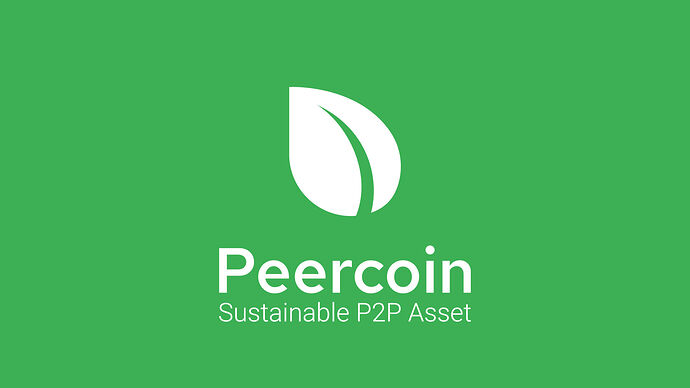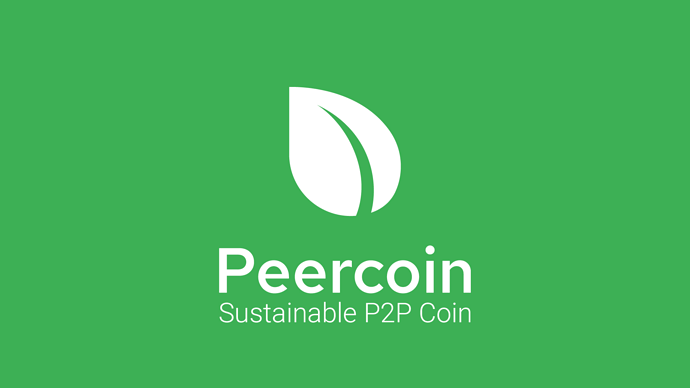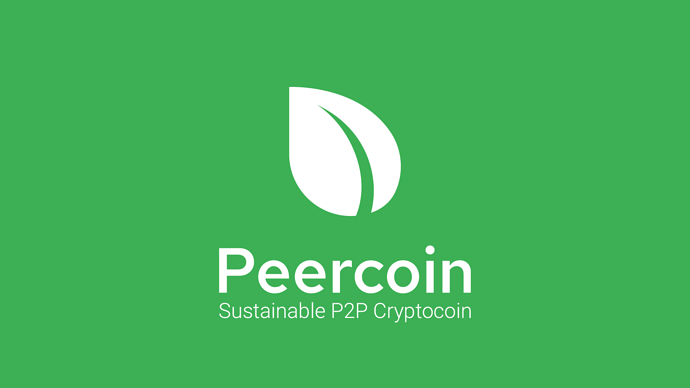Edit: A new slogan has already been chosen based on the discussion that took place in this thread. We can continue to use this thread as a place to talk about improvements to Peercoin’s messaging.
The following is the result of a discussion I had with Peerchemist over the past 2-3 weeks. It started with talking about a simple slogan change, but ended up developing into a discussion about our entire messaging strategy and whether it needs to change. So I’ll start at the beginning…
Slogan Change
We have been using our current slogan for about a year now…
“Green Crypto for a Sustainable Future”
Peerchemist told me recently that he wanted to move away from using the term crypto because of how closely it has become associated with scams. This meant that we needed to change our slogan again.
While the current slogan sounds nice, I do think it has its faults. It’s quite long for one, which makes the text appear very small under the main Peercoin logo. We’d prefer something shorter and more descriptive. Peerchemist looked around and noticed that Bitcoin uses the following slogan on their main website…
“Open Source P2P Money”
That’s a very nice short and descriptive slogan for Bitcoin. And since Peercoin has always been meant as a drop-in replacement for Bitcoin, I thought it would make sense for us to play off of their slogan. Rather than open source though, I thought we should switch the focus to something Peercoin is known for, sustainability…
“Sustainable P2P Money”
Sustainability in Peercoin
You may notice that the word green has been dropped here. Even though “green” is a trendy word these days due to climate change activism, the term does not fully encompass what it means for Peercoin to be sustainable. Yes, Peercoin is efficient and uses less energy due to Proof of Stake, but that is only one aspect of Peercoin’s sustainability.
Bitcoin’s block reward will one day come to an end, and transaction fees will take over as the main source of revenue for miners. If there aren’t enough transactions, miners will be starved of fee revenue and won’t be able to cover the costs of their operations. Network security will begin to suffer as a result. This is not sustainable, which is why Peercoin’s block reward is designed to continue forever, always providing an incentive for block producers to continue minting.
It is both aspects, energy use and incentive to produce blocks, that make up Peercoin’s sustainability. The term green only covers one meaning, while sustainable covers both. We can continue using green to describe Peercoin’s energy efficiency, but at least for our slogan, sustainable is the better choice as it encompasses all aspects.
What is Money?
Now while Peerchemist liked how short and descriptive this new slogan was, he disagreed with the use of the word money. At this point, we got into a two week debate about whether crypto is actually money or not.
This included some research into famous economists about exactly how commodities like gold transitioned into mediums of exchange, and also research into what money is. Murray Rothbard of the Austrian school of economics has a good statement about this…
So according to Rothbard, money is a commodity first. And the main difference between normal commodities and money is that money is demanded mainly as a medium of exchange.
Carl Menger says it another way, that money is the most saleable of commodities. This means that out of all the goods and commodities in the world, money consists of the commodities that are most readily accepted if you were to sell them. They are most saleable because most people will accept them on trade.
Today the US Dollar holds the title as being the most saleable commodity in the world. Yes, I understand that USD is usually considered a currency, but as Rothbard points out, money is a commodity first, traded just like any other good.
Can Crypto Become Money?
With that understanding out of the way, now the question becomes whether it is possible for Bitcoin to outcompete USD as the most saleable commodity. So far at least, we’re not seeing it. Even though more people are using Bitcoin every year, most of that use consists of price speculation, rather than trading it for real goods.
It is true that a lot of stores now accept BTC for trade, but they don’t usually hold the BTC that is sent to them. These companies utilize crypto payment providers that immediately dump the BTC on the market in exchange for the more price stable USD. These companies accept BTC just as a way to get their hands on more USD. Similarly, price speculators trade BTC just as a way to accumulate more USD. BTC is simply the means. USD is the end.
This is how things stand right now, but this might not always be the case. Things could always change over time as more of the world population becomes comfortable transacting with crypto. However, Peerchemist seems to believe that it’s incredibly difficult for BTC or any crypto to seriously compete with USD for the role of money. He says that we no longer use commodities like gold as money because fiat currency evolved the way money works and surpassed gold in usefulness.
In his opinion, it is because of the flexibility of the central bank. Central banks are capable of receiving data from the market and employing various economic tools and mechanisms at their disposal to adjust and stabilize the price of fiat currency. In this way, central banks make it possible for fiat currency to be agile and more responsive to market conditions than crypto with predefined economics. Since crypto lacks these same economic tools, it will always be more volatile than fiat currency. And as long as crypto remains volatile, it has no chance of surpassing USD in saleability.
The only thing that could change this scenario is if central banks seriously mismanaged their currencies and devalued them to the point where public trust is lost. Then people who lost their faith in fiat would need to look for alternatives, Bitcoin being one option. Peerchemist seems to believe this scenario will not occur though, and fiat currencies will be just fine.
Varying Qualities of Gold, Crypto & Money
If Peerchemist is right about this, then crypto will most likely never become money in the way that we have all come to understand it, a financial tool for everyday transactions. But that does not mean crypto is useless. For example, even though gold is no longer used as money for daily transactions, it still finds use as a long-term store of value, as well as a hedge against the collapse of the fiat currency system.
Gold can act as a backup to the financial system because it has a number of inherent properties that differentiate it from fiat money. Gold is more durable, since paper money can easily be destroyed by ripping or burning it, and since over 90% of fiat resides on digital ledgers, it can be destroyed by a few EMP blasts. The supply is also limited by the amount of gold that can be pulled out of the Earth each year (about 1-2% annual supply increase). Meanwhile, fiat money is only limited by the decisions of central bankers. If they make a mistake or mismanage by creating too much fiat, they will devalue the currency. The same cannot be done with gold, as there is a natural hard limit placed on it by the amount that is possible to be mined each year, ensuring scarcity. On the other hand, fiat money is more portable, as it is easier to carry around and store. And as long as central bankers make the right decisions about how much to create and inject into the economy, the price of fiat will also continue to be more stable than gold, leading to more acceptance and a higher degree of saleability.
Likewise, crypto also has its own unique properties that differentiate it from gold and fiat money. Crypto requires computers, energy, and the internet in order to function properly. Gold is still more durable because it requires none of these to be useful. Gold can survive world wars and even an asteroid impact. Crypto relies on modern infrastructure, which could be impaired during events like this.
Crypto has benefits over gold and money also. Crypto has programmable inflation, which means inflation of the supply no longer needs to rely on uncertain events, such as how much gold is pulled out of the Earth, or how much fiat money is created by central bankers. Thanks to crypto, the degree of annual inflation is now something that can be hard coded into a blockchain, allowing users of a particular crypto network to know exactly what percent the supply will inflate by each year.
Programmable inflation sounds like a good thing, but it can also be negative. While decentralization allows users to trust that inflation won’t change unless the network comes to consensus on changing it, it also prevents the flexibility required to stabilize the value of crypto. Central bankers can act much more swiftly in responding to economic conditions than a decentralized body of people scattered all over the world.
In everyday use, crypto is more divisible than gold and fiat, creating more accuracy by allowing division by up to eight decimal points in some blockchains, and six in Peercoin. Transactions are censorship resistant and non-reversible due to the security innovations of the blockchain. It is more portable than gold, as your entire balance can be carried around with you on your phone. Try that with heavy gold bars! Funds can also be sent around the world in 10 minutes or less depending on the blockchain, making for a quick transfer of value.
What is Peercoin if Not Money?
As we can see, crypto has its own unique properties that differentiate it from all financial tools that have come before it. However, while all crypto requires computers, energy and internet, not all blockchains are created equal. For example, Bitcoin, Peercoin and Ethereum all operate in different ways. They have different security protocols, inflation rates, and fulfill different roles. When considering Peercoin’s specific properties, what is it designed to be useful for?
Peercoin is a digital P2P asset that exists somewhere between gold (as a long-term store of value) and fiat (as money). It’s a brand new class of digital asset that has aspects of both and lives on a blockchain. It has sane economics due to a continuous annual inflation of 2-3%. This inflation provides a permanent incentive to produce new blocks, decreases hoarding by increasing velocity (movement of assets), and increases liquidity on the market for easier trade. Peercoin is also inexpensive to sustain and incredibly difficult to kill.
Peercoin is more of a long-term store of value than fiat money, and it is more mobile and easier to transact with than gold. It is stuck right in between these other two asset classes (long-term store of value and money), something which should help define Peercoin’s usefulness as an asset.
I would say that Peercoin is a more mobile store of value. Said another way, it is gold-like, in that it can be used as a vehicle for long-term savings (interest generation included), but it is also more easily transacted with because of its digital nature. And as there is more demand for a P2P savings account like this, the price of Peercoin should also scale up to match the number of people using PPC to store their value.
“Sustainable P2P Asset”
On that note, here is the slogan that we came up with so far. We simply dropped the word money in favor of the word asset. At the time we chose this, it was because an asset is a non-specific thing of value. It is a word that is free from people’s preconceived notion that crypto has to be money. It was purposely generic.
From Peerchemist’s post below though, it seems that he has had second thoughts about it and now prefers “Sustainable P2P Cryptocoin.” I questioned him about his use of crypto since he originally wanted to get away from using that term. He explained that crypto and cryptocoin mean different things. Crypto is generic, while cryptocoin means something specific, which he elaborates on below.
Change in Peercoin’s Messaging
Notice that the above descriptions do not depend on Bitcoin to describe what Peercoin is. That is another problem area that we discussed. Peercoin’s messaging includes all the content on our website, the Peercoin Primer video series from Chronos, Peercoin University, and the arguments we use on social media to convince people about why they should own and use PPC.
We believe there is a problem in our core messaging that needs to be fixed, and it has to do with our strong reliance on using Bitcoin to explain what Peercoin is. Here are some examples of this…
- Proof of Stake is a green alternative to Proof of Work.
- Peercoin was designed as a sustainable replacement for Bitcoin.
- Peercoin consistently maintains code compatibility with Bitcoin, making it the perfect drop-in replacement.
- Peercoin is the natural successor to Bitcoin.
These are all things you’ve seen me say over and over again throughout the past decade. In fact, the entire Peercoin University article is focused on Peercoin’s benefits over Bitcoin to the point that the first half of the article explains how Bitcoin works.
Peerchemist believes that I may have been framing our arguments wrong this whole time and it may be having the opposite effect of what I intended. Because to the average crypto investor, Bitcoin is king and is perfect. By explaining Peercoin within the context of Bitcoin, we must compare ourselves and publicly attack Bitcoin. This offends Bitcoiners and the average crypto investor, pushing them away from us. People reflexively hate what conflicts with their convictions.
Further, this framing connects us at the hip with Bitcoin, so whatever narrative Bitcoin is going with these days, it also becomes Peercoin’s narrative through association because we have been telling people a simplified version of the truth that Peercoin is like Bitcoin, but greener. We don’t want people to define Peercoin through Bitcoin.
Peerchemist explained to me that Peercoin does not currently have a narrative that is understandable to the average crypto investor, and that we must find a place for Peercoin to exist in this world without relying on Bitcoin to describe it. We need a convincing argument that it is useful for people to have a small fraction (percent of a percent) of peercoin in their crypto portfolio.
This thread suggests a new way of explaining Peercoin outside the context of Bitcoin, avoiding direct comparisons. It’s a starting point for a change in messaging. We would like to hear the community’s opinion on the updated messaging and if there are any suggestions to improve it further.
Peerchemist also adds some of his thoughts in the post below…


